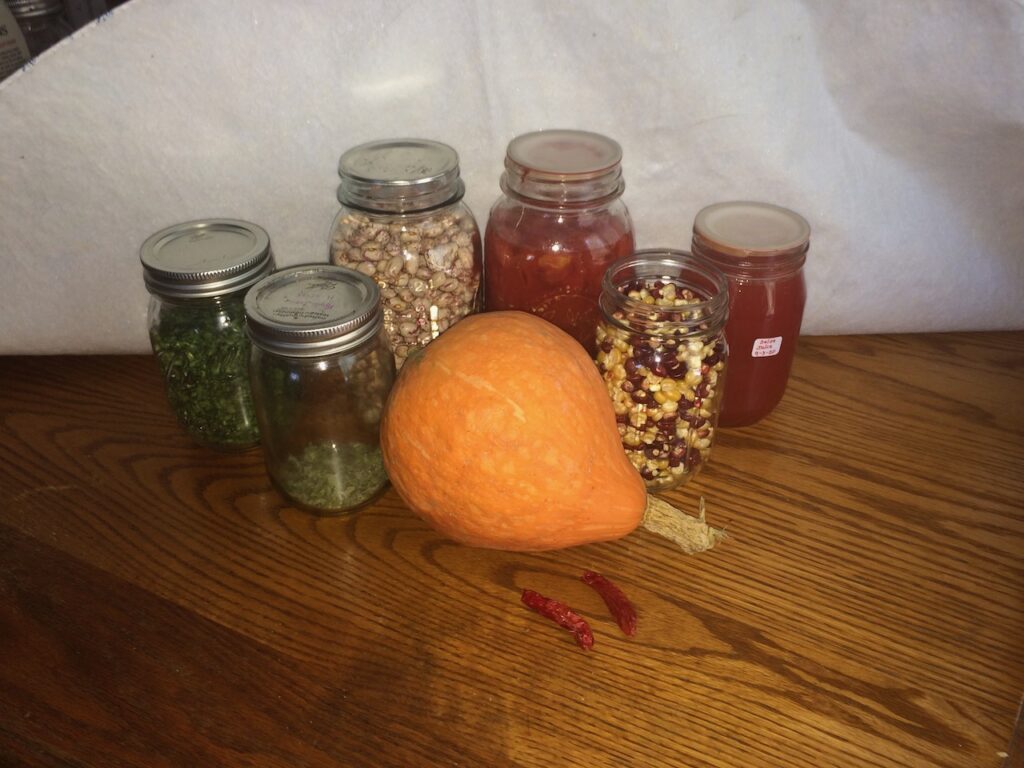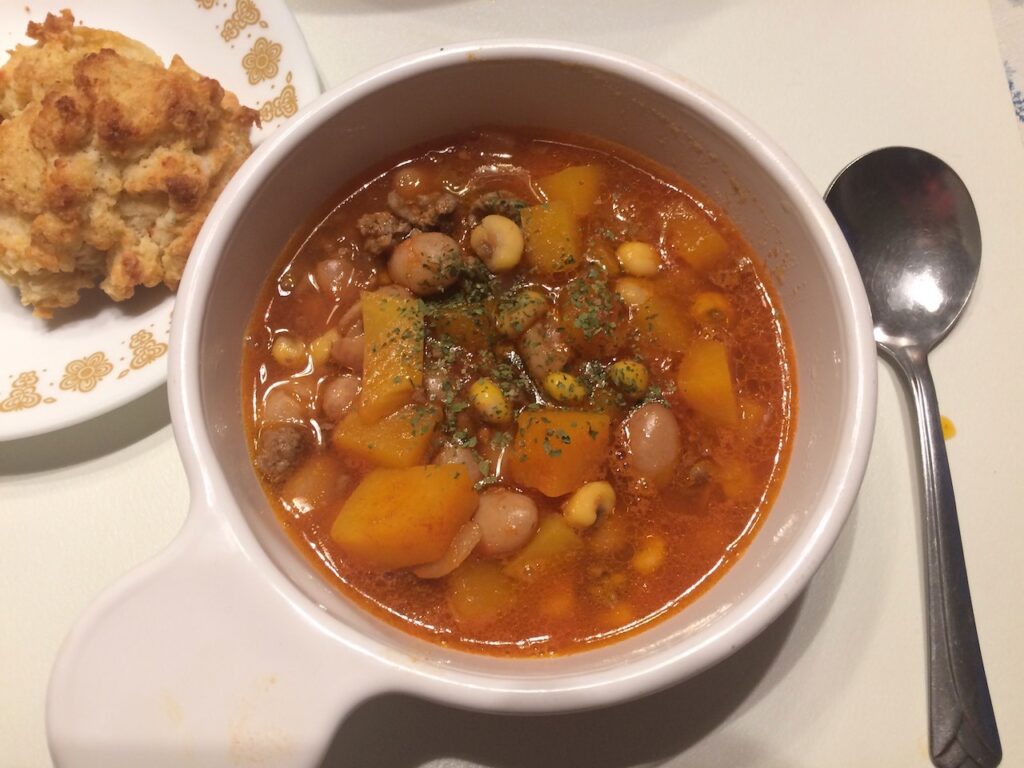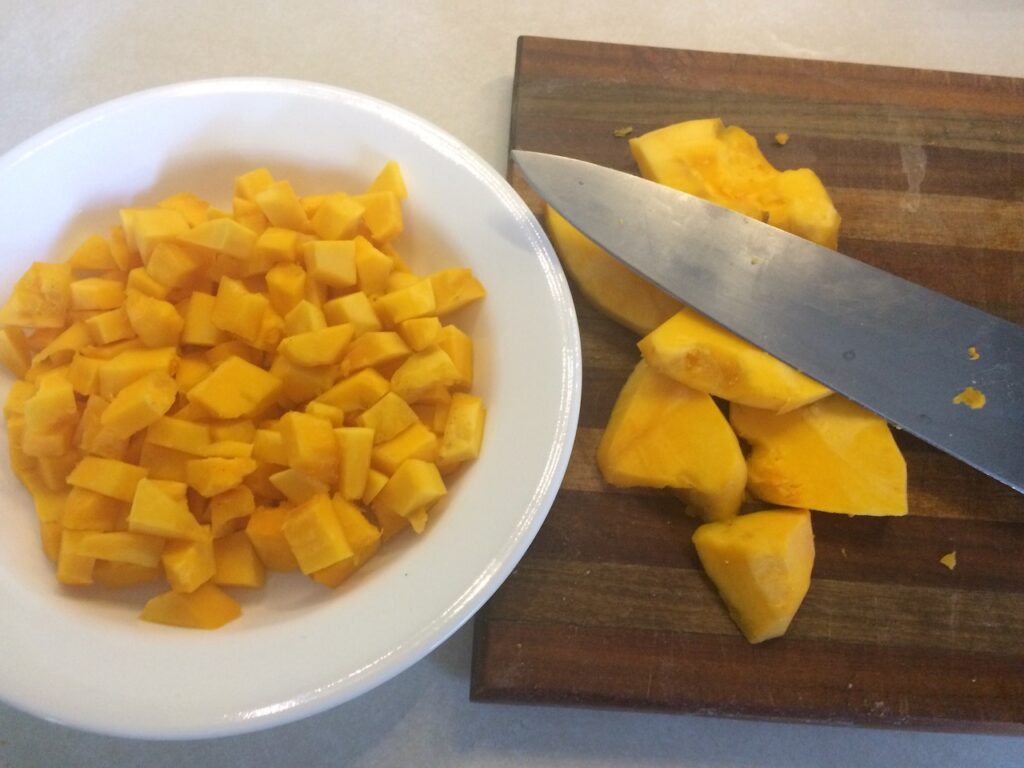If you grow a garden to be less dependent upon industrial food, or as a survival skill, a useful exercise is to try making a meal out of only what you grew in your garden. We have become so accustomed to a wide variety of foods, so you might feel limited.

Regular readers will already know that every year I try to hone my skills at growing the Three Sisters — corn, beans, and squash. It seems like every year I mess up on something but learn from my mistakes and the next year goes a little bit better. One of the endearing features of the Three Sisters is that each of them store well for winter: dry corn, dried beans, and winter squash.
So, a snowy, cold February weekend seemed like a good time to dig into that stored garden produce and make a meal out of what we grew. This dish is, not surprisingly, close to my previous dish last May — Homestead Stew.
Three Sisters, Plus
The primary ingredients are corn, beans, and squash. They’re prepared somewhat separately before adding to a crushed tomato and tomato juice base. Tomatoes and peppers aren’t among the sisters, but they are all native to the Americas and grown by Native Americans before the Europeans “discovered” them.

To spark things up a bit, we diced up two hot peppers — dried from last year’s harvest — and onion. For additional flavor: dried onion-top “chives” and dried cilantro. All of these came from the gardens, dried or stored for winter dining.
Pre-Prep How To
A more traditional recipe follows, but here are a couple of preparation notes first. The corn in my soup had to become hominy first. I grow a variety of flint corn that dries on the cob and stores well for years. I’ve got a post on hominy, in case you missed it, so I won’t go into all that here. Everything else was either dried and thrown into the broth to re-hydrate, or “fresh” stored, like the squash and onions.
The goal of this soup was to use what we grew. This underscores the value in raising a diverse garden — especially in foods that can be preserved for winter consumption. This exercise has me thinking about what else I could grow (and be able to store/preserve) to add variety and versatility.
If you had a garden this past season, were you able to save some of that harvest for these cold winter months? If push came to shove and you planned to survive the winter in what you grew in your garden, what would you grow?
Three Sisters Soup

Ingredients:
- 1 pint of dry beans (soaked overnight)
- 1 cup of dry corn (turned into hominy)
- 3 cups of squash (cubed)
- 1 quart of canned tomatoes
- 1 quart of tomato juice*
- 2 dried hot peppers (diced fine)
- 2 “Walking onions” (diced) (sub. 1 med. store-bought onion)
- 1/2 c of onion-top chives (sub. Diced scallion tops)
- 1/4 c of dried cilantro.
- (salt to taste)*
* Our tomato juice is salty. We save and can the juice from the ‘brining’ of tomatoes for our salsa. So, I didn’t have to add much salt. If you use plain (unsalted) tomato juice you might need a teaspoon or more of salt — to taste.
Process
Beans: Clean and set your dry beans soaking the night before. Slightly warm water soaks faster than cold water, but don’t get the water too warm that you’re pre-cooking them. The beans get prone to breaking up and turning to mush.
Corn: Soak the cup of dry kernels in 4 cups of water with a half cup of sifted wood ash. You don’t need to boil them. Simmering on low for a couple of hours may be enough. It depends on the heat. When the hard outer shell has softened to a gelatinous sort of condition and you can rub that shell off the kernel, they’re done soaking in ash water. Rinse thoroughly, as it says in the hominy post.
Put the hominy and beans in a stockpot with the tomatoes and tomato juice. Heat to a medium-low boil. Start the clock. It will take about an hour for the beans to cook to the ‘done’ texture.
Add the finely diced dried hot pepper. If you like things hot, include more of the seeds. Keeping most of the seeds out reduces the hotness. Your choice.
Stir periodically, if only to keep the beans from just sitting on the bottom, but don’t over stir. That breaks up the beans too. Just enough to ensure it’s not sticking to the bottom and everything is getting cooked evenly.
No squirrel meat this time. The few remaining ones are avoiding me.
Squash: Peel and ‘gut’ the squash. We used a medium-small Hubbard, but butternut, buttercup, or other winter squashes will work too. Dice into 1/2” cubes. They need to be that small to cook all the way through and yet not turn to mush.

Put squash cubes into the boiling broth at the 40 minute mark. The squash only needs about 20 minutes to soften.
At the 50 minute mark, add the diced onion.
When the beans are done, everything else should be too. Stir in the dried “chives” and cilantro, and serve. A little poof of cilantro in the middle of the bowl looks artsy. 🙂
Enjoy! Makes about 8 servings, depending on how big your bowls are.
Nutrient Notes
The hominy and beans are a carb and protein source that sustained the Native Americans for thousands of years. The squash adds vitamins A and C as well as a hint of sweetness to balance the acidity of the tomatoes. The peppers and onions add some zest to what would otherwise be a somewhat bland dish.
Do you have any recipes for dishes that use (mostly) what you grew in your garden?
—

Good article Mic. I hope to try this exercise next winter.
The Three Sisters Soup looks amazing Mic. I do the same sort of thing when it comes to our garden but I like to add things from our pantry as well. I’d say on average we probably cook exclusively from our pantry stored foods, some of it from our garden, about once a week.
That’s not grabbing something from the pantry for dinner, that’s most days, I’m talking about making it a point to stay out of the refrigerator or freezer when cooking dinner.
It’s a challenge at first but then you begin to discover holes in your pantry and start stocking up on the shortcomings. Eventually, we found it easy to make any number of meals from long-term food storage without leaving anything out.
I think it would be fun to expand on that and actually cook the meal off-grid as well.
Good stuff Mic, thanks.
Hi Brian.
That’s a great idea about practicing cooking with prepped backup methods as well as working with stored foods.
— Mic